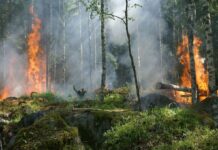THUNDER BAY – Wildfire Update – The fire situation across the North continues to ramp up as the region warms up and dries out. The overall hazard has climbed to either high or extreme for much of the region. That means taking extra care to ensure that man-made fires are less of a factor.
May 29, 2019 – Time of Report 17:39
Northwest Region
There were four new forest fires confirmed by the afternoon of May 29.
- Red Lake Fire Number 12 is not under control at 20 hectares and is located near Hansen Lake, approximately 53 kilometres west of Red Lake.
- Red Lake Fire Number 13 is not under control at 7.5 hectares and is located near Dixie Lake, approximately 23 kilometres south of Red Lake.
- Dryden Fire Number 4 has been declared out at 0.1 hectares and was located near Banana Lake, approximately 16 kilometres northeast of Dryden.
- Red Lake Fire Number 14 is not under control at 12 hectares and is located approximately 5 kilometres north of Pikangikum First Nation.
Fire hazard in the Northwest Region
The forest fire hazard is high to extreme across most of the region with an area of moderate hazard in Nipigon and northern Sioux Lookout district.
AFFES staff deployed to Alberta
More than 200 staff members from Aviation, Forest Fire and Emergency Services are assisting the province of Alberta with its escalated fire situation. This includes FireRangers, support staff and one incident management team. In addition, the Ministry of Natural Resources and Forestry is providing equipment such as pumps, hose and hand tools to support Alberta.
The sharing of resources across Canada is facilitated by the Canadian Interagency Forest Fire Centre in Winnipeg under the Mutual Aid Resource Sharing agreement.
The fire situation in Ontario has been relatively quiet since the beginning of the 2019 fire season, and we remain fully prepared to respond to any forest fires that may arise here at home.
Help prevent forest fires
Adopt safe campfire practices! Choose the site of your campfire carefully and keep your fire small. Stay nearby: never leave it unattended. Put your fire out by drowning it with water. Be sure that it is extinguished prior to leaving the site. Stir the ashes with a stick to uncover hot coals and then drown it again. You can never be too safe.
Consider alternatives to burning brush or yard waste, such as chipping or composting when possible, or saving burn piles for the fall or after the fire season. Use of outdoor fires must follow the outdoor burning rules set out in the Forest Fire Prevention Act of Ontario. Fires are to be started no sooner than two hours before sunset and extinguished no later than two hours after sunrise. Fires should never be left unattended and tools and water should be close at hand to put the fire out. More details on outdoor burning regulations can be found online at Ontario.ca/forestfire
To see a complete list of fires across the province click on our interactive map. You can also get the latest update on the condition of any fire by clicking the fire icon.
Fire numbers and online information:
- Forest Fire Reporting Number – 310-FIRE (3473)
- Twitter account







